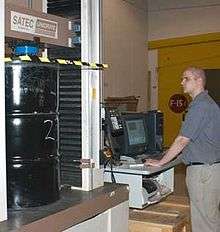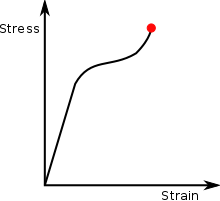Compressive strength
Compressive strength or compression strength is the capacity of a material or structure to withstand loads tending to reduce size, as opposed to which withstands loads tending to elongate. In other words, compressive strength resists being pushed together, whereas tensile strength resists tension (being pulled apart). In the study of strength of materials, tensile strength, compressive strength, and shear strength can be analyzed independently.
Some materials fracture at their compressive strength limit; others deform irreversibly, so a given amount of deformation may be considered as the limit for compressive load. Compressive strength is a key value for design of structures.

Compressive strength is often measured on a universal testing machine. Measurements of compressive strength are affected by the specific test method and conditions of measurement. Compressive strengths are usually reported in relationship to a specific technical standard.
Introduction
When a specimen of material is loaded in such a way that it extends it is said to be in tension. On the other hand, if the material compresses and shortens it is said to be in compression.
On an atomic level, the molecules or atoms are forced apart when in tension whereas in compression they are forced together. Since atoms in solids always try to find an equilibrium position, and distance between other atoms, forces arise throughout the entire material which oppose both tension or compression. The phenomena prevailing on an atomic level are therefore similar.
The "strain" is the relative change in length under applied stress; positive strain characterises an object under tension load which tends to lengthen it, and a compressive stress that shortens an object gives negative strain. Tension tends to pull small sideways deflections back into alignment, while compression tends to amplify such deflection into buckling.
Compressive strength is measured on materials, components,[1] and structures.[2]
By definition, the ultimate compressive strength of a material is that value of uniaxial compressive stress reached when the material fails completely. The compressive strength is usually obtained experimentally by means of a compressive test. The apparatus used for this experiment is the same as that used in a tensile test. However, rather than applying a uniaxial tensile load, a uniaxial compressive load is applied. As can be imagined, the specimen (usually cylindrical) is shortened as well as spread laterally. A stress–strain curve is plotted by the instrument and would look similar to the following:

The compressive strength of the material would correspond to the stress at the red point shown on the curve. In a compression test, there is a linear region where the material follows Hooke's law. Hence, for this region, , where, this time, E refers to the Young's Modulus for compression. In this region, the material deforms elastically and returns to its original length when the stress is removed.
This linear region terminates at what is known as the yield point. Above this point the material behaves plastically and will not return to its original length once the load is removed.
There is a difference between the engineering stress and the true stress. By its basic definition the uniaxial stress is given by:
where, F = Load applied [N], A = Area [m2]
As stated, the area of the specimen varies on compression. In reality therefore the area is some function of the applied load i.e. A = f(F). Indeed, stress is defined as the force divided by the area at the start of the experiment. This is known as the engineering stress and is defined by,
A0=Original specimen area [m2]
Correspondingly, the engineering strain would be defined by:
where l = current specimen length [m] and l0 = original specimen length [m]
The compressive strength would therefore correspond to the point on the engineering stress strain curve defined by
where F* = load applied just before crushing and l* = specimen length just before crushing.
Deviation of engineering stress from true stress

In engineering design practice, professionals mostly rely on the engineering stress. In reality, the true stress is different from the engineering stress. Hence calculating the compressive strength of a material from the given equations will not yield an accurate result. This is because the cross sectional area A0 changes and is some function of load A = φ(F).
The difference in values may therefore be summarized as follows:
- On compression, the specimen will shorten. The material will tend to spread in the lateral direction and hence increase the cross sectional area.
- In a compression test the specimen is clamped at the edges. For this reason, a frictional force arises which will oppose the lateral spread. This means that work has to be done to oppose this frictional force hence increasing the energy consumed during the process. This results in a slightly inaccurate value of stress obtained from the experiment. The frictional force is not constant for the entire cross section of the specimen. It varies from a minimum at the center, away from the clamps, to a maximum at the edges where it is clamped. Due to this, a phenomenon known as barreling occurs where the specimen attains a barrel shape.c
Comparison of compressive and tensile strengths
Concrete and ceramics typically have much higher compressive strengths than tensile strengths. Composite materials, such as glass fiber epoxy matrix composite, tend to have higher tensile strengths than compressive strengths. Metals are difficult to test to failure in tension vs compression. In compression metals fail from buckling/crumbling/45deg shear which is much different (though higher stresses) than tension which fails from defects or necking down.
Compressive strength of concrete
For designers, compressive strength is one of the most important engineering properties of concrete. It is a standard industrial practice that the concrete is classified based on grades. This grade is nothing but the Compressive Strength of the concrete cube or cylinder. Cube or Cylinder samples are usually tested under a compression testing machine to obtain the compressive strength of concrete. The test requirements differ country to country based on the design code. As per Indian codes, compressive strength of concrete is defined as
The compressive strength of concrete is given in terms of the characteristic compressive strength of 150 mm size cubes tested after 28 days (fck). In field, compressive strength tests are also conducted at interim duration i.e. after 7 days to verify the anticipated compressive strength expected after 28 days. The same is done to be forewarned of an event of failure and take necessary precautions. The characteristic strength is defined as the strength of the concrete below which not more than 5% of the test results are expected to fall.[4]
For design purposes, this compressive strength value is restricted by dividing with a factor of safety, whose value depends on the design philosophy used.
See also
- Buff strength
- Container compression test
- Crashworthiness
- Deformation (engineering)
- Schmidt hammer, for measuring compressive strength of materials
- Plane strain compression test
References
- Urbanek, T; Lee, Johnson. "Column Compression Strength of Tubular Packaging Forms Made of Paper" (PDF). 34, 6. Journal of Testing and Evaluation: 31–40. Retrieved 13 May 2014. Cite journal requires
|journal=(help) - Ritter, m A; Oliva (1990), "9, Design of Longitudinal Stress-Laminated Deck Superstructures" (PDF), Timber Bridges: Design, Construction, Inspection, and Maintenance, US Dept of Agriculture, Forest Products Laboratory (published 2010), retrieved 13 May 2014
- Kermani, Majid; Farzaneh, Masoud; Gagnon, Robert (2007-09-01). "Compressive strength of atmospheric ice". Cold Regions Science and Technology. 49 (3): 195–205. doi:10.1016/j.coldregions.2007.05.003. ISSN 0165-232X.
- "Compressive Strength of Concrete & Concrete Cubes | What | How | CivilDigital |". 2016-07-07. Retrieved 2016-09-20.
- Mikell P.Groover, Fundamentals of Modern Manufacturing, John Wiley & Sons, 2002 U.S.A, ISBN 0-471-40051-3
- Callister W.D. Jr., Materials Science & Engineering an Introduction, John Wiley & Sons, 2003 U.S.A, ISBN 0-471-22471-5

